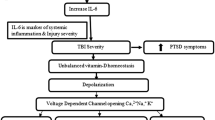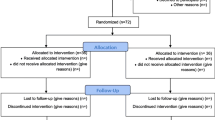1. The main idea of the open clinical trial was to compare the income and outcome clinical picture and the evolution of the biochemical markers in the defined intervals in closed head injury group patients.
2. In the group of 32 patients, mean age 40.78±15.36 years suffering from closed traumatic brain injury the following markers were measured: glycaemia, malondialdehyde (MDA) as marker of lipid peroxidation, beta-caroten, total SH groups as marker of protein oxidation in the following intervals: between the 1st and the 3rd, between the 3rd and the 7th, between the 1st and the 7th day respectively.
3. Glycaemia significantly decreased since the 1st day till the 3rd day (p < 0.05) and since the 1st day till the 7th day (p < 0.05) but it was not significantly changed since the 3rd day till the 7th day (p > 0.05).
4. MDA 1st × MDA 3rd p > 0.05 insignificant change, MDA 1st × MDA 7th p < 0.001—high significant decrease, MDA 3rd × MDA 7th—p < 0.0001—very high significant decrease.
5. Beta-caroten the 1st × beta-caroten the 3rd day was insignificantly changed—p > 0.05, the 3rd × the 7th day beta-caroten increased significantly—p < 0.0002, the 1st day × 7th day beta-caroten significantly increased—p < 0.0001.
6. We examined the SH groups only in nine patients, due to technical problems and SH groups decrease on the 3rd day (p < 0.005).
7. In 18 amantadine sulphate subgroups (randomly selected), there was 5.5% lethality and mean outcome GCS (outGCS) 9.83±3.8, while lethality of the control subgroup (n=14) was 42.9%, mean outGCS 6.28±3.5.




Similar content being viewed by others
REFERENCES
Drobný, M., and Sániová, B. (2002). Amantadín sulfát PK-Merz a jeho vplyv na osud pacientov s ťažkými traumatickými poškodeniami mozgu. MERZ Slovakia, pp.1–7.
Frykholm, P. (2002). Cerebral Ischemia Studied with Positron Emission Tomography and Microdialysis, Acta Universitatis Upsaliensis Uppsala, Printed in Sweden by Fyris-Tryck AB, Uppsala, pp. 8–72.
Jorg, J., et al. (2000). Amantadine sulfate infusion in the treatment of vigilance and drive disorders. Nervenheilkunde 19:521–528.
Schmidt, W. J., et al. (1996). Therapeutic principle: Glutamate antagonism. Amantadine sulfate: Neuroprotective, vigilance-enhancing, virustatic life-prolonging. Nervenheilkunde. 8:1–8.
Steube, et al. (2000). The influence of amantadine sulfate on disturbances of arousal after severe traumatic brain injury. Neurol. Rehabil. 6 (6):307–312.
Tesoriere, L., et al. (2002). Exposure to malondialdehyde induces and early redox unbalance preceding membrane toxicity in human erythrocytes. Free Radic. Res. 36(1):89–97.
Wallnöfer, H., and Schiller, L. (1974). Aminoadamantan – Behandlung bei komatösen Zustandsbildern. Med. Welt. 25:703–706.
Warner D. S., et al. (2004). Oxidants, antioxidants and the ischemic brain. J. Exp. Biol. 207:3221–3231.
Author information
Authors and Affiliations
Corresponding author
Rights and permissions
About this article
Cite this article
Saniova, B., Drobny, M., Lehotsky, J. et al. Biochemical and Clinical Improvement of Cytotoxic State by Amantadine Sulphate. Cell Mol Neurobiol 26, 1473–1480 (2006). https://doi.org/10.1007/s10571-006-9033-0
Received:
Accepted:
Published:
Issue Date:
DOI: https://doi.org/10.1007/s10571-006-9033-0




